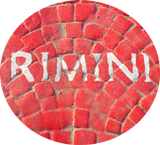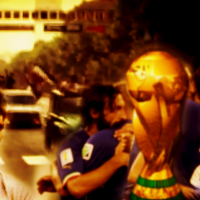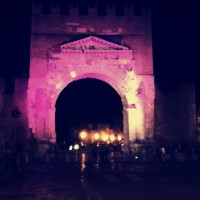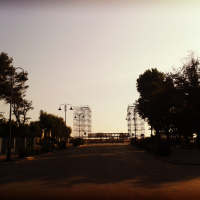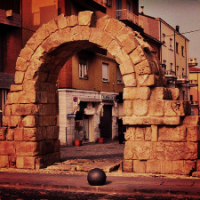Mondaino
Mondaino, originally known as Vicus Dianensis sits on a hilltop that perfectly commands the route between Rimini and Urbino. As such it was of strategic value to both the Malatesta and Montefeltro families who fought consistently throughout the 1400s, while today it makes it a perfect stopping off point on a tour of the countryside between Emilia-Romagna and the Marche.
The town is thought to have grown from an original settlement in Roman times dedicated to Diana, the Godess of the forests. The modern name, Mondaino, derives from the name Mons Damarum or ‘fallow dear mountain’. Records show that the town was ruled by Pietro Benone in the 1100s, before becoming an object of interest to both the Malatesta and Montefeltro families. In 1393 Carlo Malatesta (Uncle of Sigismondo Pandolfo Malatesta) and Anotnio II da Montefeltro (grandfather to Federico III da Montefeltro) agreed on a peace treaty here. Later, in 1459 those famous arch enemies Sigismondo and Federico would agree another peace treaty here, but as with previous treaties it was short lived – something attested to by the sturdy fortress that the Malatesta built here and which now houses an impressive palaeontology museum
Nowadays the town has a population of roughly 1,500. Alongside agricultural production, the town is famous for its production of accordions(!) as well as, more recently, electronic instruments.
Things to see in Mondaino
Mondaino’s Rocca Malatestiana
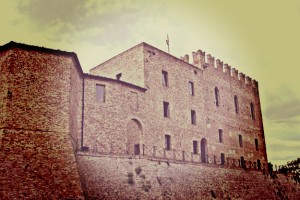 There are plenty of castles in the valleys outside RImini, testament to the ferocious struggle between competing authorities in central Italy throughout the middle-ages, and Mondaino’s Rocca Malatestiana is typical of a border castle of that time (It’s situated almost exactly halfway between Urbino and Rimini – being slightly closer to Urbino, though nowadays it is in the administrative province of Rimini).
There are plenty of castles in the valleys outside RImini, testament to the ferocious struggle between competing authorities in central Italy throughout the middle-ages, and Mondaino’s Rocca Malatestiana is typical of a border castle of that time (It’s situated almost exactly halfway between Urbino and Rimini – being slightly closer to Urbino, though nowadays it is in the administrative province of Rimini).
It was built as one link in a network of castles, and is particularly sturdy with sloping walls and impressive ghibeline merlons – a merlon forms the solid part of an embattled parapet, sometimes pierced by embrasures, deriving some have suggested from the medieval latin word merelus or blackbird, the image being of a row of blackbirds sitting on the parapet. In Italy during the Guelf Ghibeline conflict the two sides (however loosely ‘side’ should be used here) adopted different style merlons – the Ghibelline extending like a swallow’s tail.
The Castle was built progressively between the XIII and XV centuries, with much of the work being undertaken by Sigismondo Pandolfo Malatesta, who added up to 13 towers to the structure and a series of walls. His rival Federico described Mondaino at the time as a strong-hold practically impossible to conquer.
Every great castle needs a great ghost story to accompany it, and Mondaino’s is one of the best. The renaissance poet Giovanni Muzzarelli, who was appointed ruler of the town in 1514, disappeared in 1516. In the well of the castle, later, a gold ring with the stem of the city was found. It’s suggested that the men of the town, jealous of his appointment (imposed by the Pope in Rome), set upon him one evening and threw him, and his trusty mule, into the well where he died a slow and painful death. An alternative theory suggests that the name ‘Giustina’ was found scrawled into the wall of the well – the name of one of Muzzaerlli’s lovers, whose angry husband killed the poet. Tradition suggests that, either way, the ghost of the poet lingers in the castle to remind visitors of his grisly death.
The Castle has a number of secret passageways, tunnels and concealed doors, all adding to its sense of mystery. One chamber has an impressive Fresco by Bernardino Dolci, from around 1485, of the Virgin Mary Breastfeeding the infant Jesus. This fresco caused a bit of a stir earlier this year, when some visitors noted the faded presence of a monkey-like figure on the Virgin’s shoulder. Local art historians have dismissed the idea as an optical illusion, while other theories have suggested that this is in fact a demon, poised on the Virgin’s shoulder to warn the faithful against staring at her uncovered breast. Fanciful? Make up your own mind visiting.
The Piazza Maggiore – nicknamed the Frying Pan Piazza
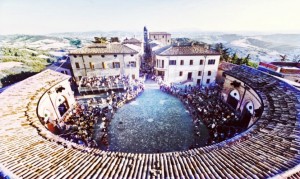 This 19th century piazza, which is the centre of town-life in Mondaino, is one of the most unusual and distinctive in the whole of the region of Emilia-Romagna – so much so that it’s hard to find a tourist brochure or poster that doesn’t figure it somewhere. Designed by the architect Francesco Cosci in 1800, the piazza has a semi-circular shape bordered by a neo-classical portico. Because of its shape it has become known locally, with affection, as the padella or frying pan.
This 19th century piazza, which is the centre of town-life in Mondaino, is one of the most unusual and distinctive in the whole of the region of Emilia-Romagna – so much so that it’s hard to find a tourist brochure or poster that doesn’t figure it somewhere. Designed by the architect Francesco Cosci in 1800, the piazza has a semi-circular shape bordered by a neo-classical portico. Because of its shape it has become known locally, with affection, as the padella or frying pan.
It’s beautiful and quirky, set with the Medieval fortress behind and the hills of the hinterland making it worth seeing at all times. It becomes all the more impressive when, for example, the medieval festival the Palio de lo daino takes place. Seeing the costumes and competitions of long-lost age in this very particular piazza is an unforgettable experience.
The Palaentological Museum
Housed in the Rocca Malatestiana, this museum first opened its doors in 1981, and contains an impressive selection of fossils of flora and fauna from the region, which even today has a huge diversity in wildlife. The fossils date back to the miocene period (dating back about 5 million years). In particular the collection is famed for its collection of fish fossils, with up to 21 different types of species, as well as a large collection of bird fossils.
Amongst the various exhibits, there’s a detailed explanation of how fossils are formed, and a guide to the evolution of various species on display, showing how species mutated over the miocene period. There are hundreds of fossils on display, making this an important stop for both the casual visitor and enthusiast alike.
The Museum is open from October to May daily (closed on Tuesdays and Sundays) from 9.00 – 12.00, while from May to September it’s also open from 16.00 – 19.00 on Friday afternoons.
Festivals in Mondaino
There are a number of world-famous festivals held in the beautiful town of Mondaino each year. There are, obviously pros and cons to visiting when the festivals are on. The small town does become crowded, but that’s a small price to pay to witness some of these festivals – perhaps the best solution is to visit twice!
Palio de lo Daino
This is the town’s most famous festival, held annually to commemorate the brief peace treaty reached by Sigismondo Malatesta and Federico da Montefeltro in 1459. Palio is a generic term, used to describe a competition that pits different quarters of a town/city against each other. A famous example is the Palio in Siena, that pits different contrade in the city against each other in a horse-race. The Palio in Mondaino culminates, however, on foot with four amed men competing against each other in Piazza Maggiore. The Palio de lo Daino has been recognised by various national and international organisations for the veracity of its historical re-enactments, so much so that attending gives you the idea of stepping back directly into the fifteenth century! It is usually held in mid-August.
Festa di Santa Bibiana
At the end of November/ start of December, Mondaino plays host to two overlapping festivals – both food related, and both representative of centuries of tradition and taste. The first is a harvest festival for the truffle, dubbed ‘Cerere’ in honour of the ancient god of the harvest. The black truffle, or tartuffo nero is highly prized throughout the hills of the Romagna and the Marche, and used widely in cooking. Its use ranges from an ingredient in sauces, to being grated on fresh pasta. It’s added to oil, and spread on crostini. It has hundreds of uses and there’s no better place to discover them than in any one of the many festivals that spring up at harvest time in these hills. The festival also celebrates the much more prized Tartuffo bianco or white truffle, which is more aromatic and rarer than it’s black cousin, but is also found in these rich hills.
The second part of this festival is dedicated to the special cheese, which shares some characteristics with the truffles, in that it is unearthed, smells strongly, and isn’t to everyone’s taste – but for those who are fans of formaggio di fossa there’s nothing in the world like it. It’s a cheese that is prepared slowly, generally made from sheeps milk, and buried in a hole in the ground (fossa – literally a ditch or grave) to mature. The festival is dedicated to Saint Vivian (Santa Bibiana) whose body was apparently thrown to the dogs after her martyrdom, but none would touch it – best not to make that connection with the cheese!
